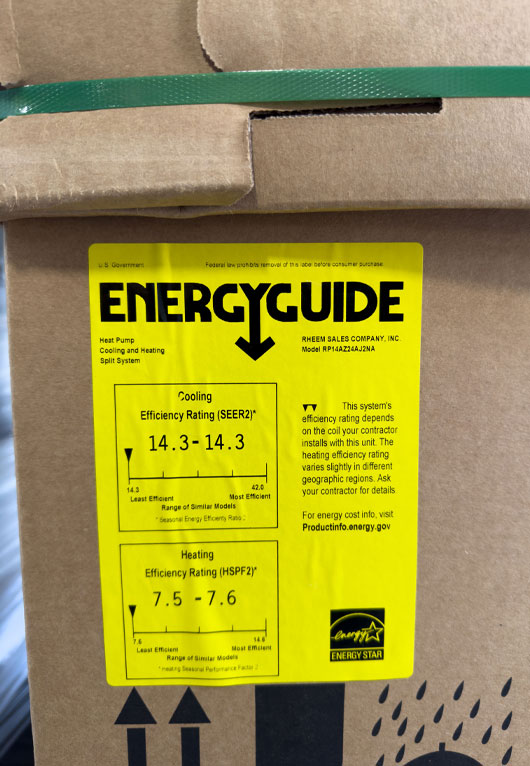SEER2 Is Here:
What That Means For New HVAC Installations
While everyone is familiar with governmental regulations about vehicle fuel efficiency, you can be forgiven for not realizing that your home’s HVAC system must follow similar efficiency standards! At the beginning of 2023 new, more stringent, regulations concerning HVAC efficiency came into effect. These changes, known as SEER2, replace the old SEER regulations, and will only apply to new installations of HVAC systems.
If you’re thinking about replacing your existing air conditioning unit or are just curious about what these changes entail, here are the important details to know about SEER2 regulations.
What is a SEER Rating?
Before diving into the changes, it is important to understand what exactly SEER is. SEER stands for Seasonal Energy Efficiency Ratio. SEER is not the only rating system that applies to HVAC systems and exists alongside EER which is a non-seasonally adjusted Energy Efficiency Ratio. For all intents and purposes, both of these efficiency ratings are measuring the same thing – they just present slightly different results.
A SEER ratio is calculated by taking the total cooling output of an air conditioner or heat pump during its normal annual usage period for cooling, divided by the total electric energy input in watt-hours during the same period.
In simpler terms, SEER is essentially calculated using this formula:
SEER = (Cooling Output over the Cooling Season [BTUs]) / (Electrical Energy Input over the Cooling Season [watt-hours])
For example, if an AC system has a cooling output of 12,000 BTUs and uses 1,000 watt-hours of electricity, the SEER rating would be 12.
The SEER measurement is based on a range of outside temperatures from 65 to 104 degrees Fahrenheit, in order to simulate a typical cooling season. This means that the SEER rating represents an average efficiency over a range of conditions, rather than a peak efficiency.
A higher SEER value indicates a more efficient air conditioning system, and thus a lower monthly utility bill. According to Lennox, switching from a SEER 10 to a SEER 15 system can reduce your HVAC energy consumption by 33% and saves the average South Carolina homeowner nearly $800 within 5 years.

What Are the Differences Between SEER and SEER2
SEER is a decades old regulation and dates back to 1992. Over the years the regulation has changed – requiring ever more efficient air conditioning units. In this way, SEER2 is not a major departure from past changes as it raises the efficiency bar slightly over the previous standards which were set back in 2015.
In addition to requiring slight increases in efficiency, SEER2 sees two other changes. The first is a switch to a coil-only rating for cooling systems. This means that the SEER score for the entire system is based on the least efficient part of the system.
The second change is where we see the biggest leap from SEER to SEER2 and relates to testing procedures. In order to determine SEER values, tests were conducted under conditions which, to be charitable, did not match those seen in field conditions.
In SEER tests, HVAC units were tested with an external static pressure of 0.1, despite the fact that in most of our homes the external static pressure is typically greater than 0.5.
You can think of external static pressure like friction for your car. If you tested your car’s MPG in a low friction environment – driving on perfectly smooth roads with over-inflated tires – then the manufacturer’s listed MPGs would be considerably higher than you could reasonably expect to get yourself.
SEER2 requires Heating and Air Conditioning Systems be tested according to the new M1 testing procedures, which uses an external static pressure of 0.5. This higher rating more closely matches the conditions found in the real world. A result of these much tougher test conditions is that an air conditioner’s SEER2 will be lower than its SEER rating – even though the unit itself hasn’t changed.
Why were the SEER2 standards established?
The SEER and SEER2 standards are written by the US Department of Energy and help to ensure that Americans have access to energy efficient appliances. The more efficient requirements of the current SEER standards are predicted to help Americans save $2.5 to $12.2 billion dollars in energy bills over the next three decades.
In addition to the updated efficiency requirements, the more accurate testing procedures will result in more trustworthy SEER ratings. Consumers will be able to trust that a SEER2 17 will actually be more efficient than a SEER2 15 when operating in real world conditions.
What Are the New SEER2 Requirements?
Just like SEER, SEER2 is a regional regulation which divides the United States into three geographical regions: North, Southeast and Southwest. In the North, for example, SEER rated air conditioner units manufactured prior to January 1, 2023 are still allowed to be sold and installed – while in the Southeast and Southwest regions only SEER2 rated units are permitted.
Southeast Region SEER2 Requirements
We’re going to only do a deep dive into the Southeastern requirements – so this list applies to you if you live in the following areas: Alabama, Arkansas, Delaware, Florida, Georgia, Hawaii, Kentucky, Louisiana, Maryland, Mississippi, North Carolina, Oklahoma, Puerto Rico, South Carolina, Tennessee, Texas, Virginia, the District of Columbia, and the U.S. Territories.
The regulations themselves are available to view here, but these are the new minimum efficiency requirements:
Minimum SEER Rating for Air Conditioners:
For units rated for 45,000 BTUs or Less: 14.3 SEER2 / 15 SEER equivalent
For units rated for greater than 45,000 BTUs: 13.8 SEER 2 / 14.5 SEER equivalent
Note: 3.5 ton units fall below 45,000 BTU while 4 ton units are above this threshold.
Minimum SEER Rating for Heat Pumps:
All units, regardless of BTUs: 14.3 SEER2 / 15 SEER equivalent
Note: Heat pumps built prior to January 1, 2023 which have a SEER of 14 or greater are still permitted to be installed.
Minimum SEER Rating for Single Package Heat Pumps:
All single packaged units, regardless of BTUs: 13.4 SEER2 / 14 SEER equivalent

Do I need to change my HVAC system to a SEER2 compliant system?
The changes from SEER to SEER2 may have you worried: will you need to replace your existing HVAC system?
The answer is very simple: No! No existing air conditioning units or heat pumps will need to be replaced. These regulations only apply to new installations.
If you were going to be replacing your unit anyway, then any replacement you choose will need to adhere to the new regulations. The good news is that the HVAC industry has had plenty of notice of the regulatory changes and testing units for SEER2 standards is the norm.
A More Efficient Future
Ultimately, the change from SEER to SEER2 won’t negatively affect homeowners or make your HVAC installation process more challenging. Manufacturers have had plenty of time to certify their units for the new standards and SEER2 models are widely available. If you have recently purchased an AC unit, or your HVAC is a few years old but otherwise operating just fine, then you have nothing to worry about and do not need to purchase a replacement.
When it comes time to install a new air conditioner, you should keep in mind that a SEER2 15 will be more efficient than an older SEER 15 model, as the testing requirements have changed. With the updated testing procedures, customers can expect to see a closer connection between an HVAC’s SEER2 rating and its real-world performance, helping everyone make informed decisions about their household’s energy efficiency.

5636 Bush River Rd.
Columbia, SC 29212
SC License – #M104545
NC License – #32356
Phone: (803) 794-5526

